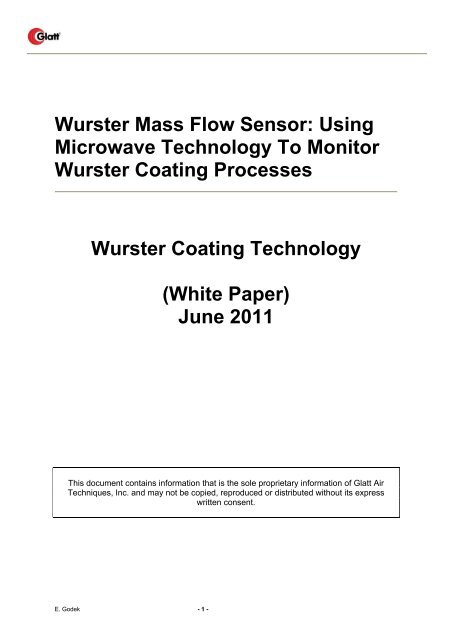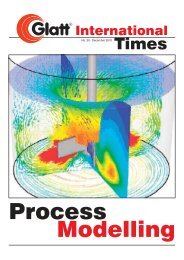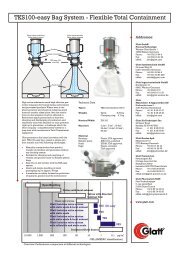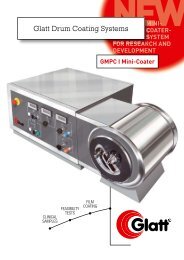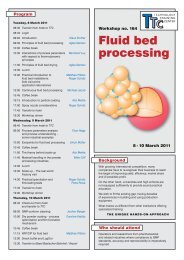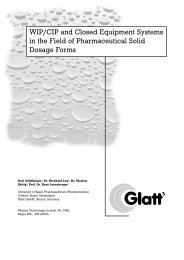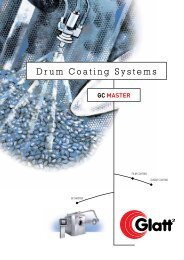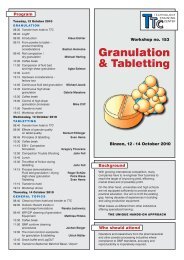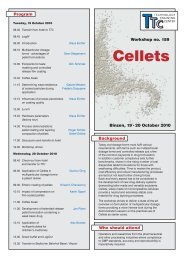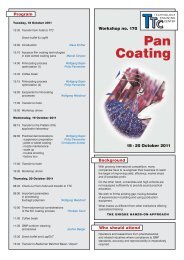Wurster Mass Flow Sensor: Using Microwave Technology To - Glatt
Wurster Mass Flow Sensor: Using Microwave Technology To - Glatt
Wurster Mass Flow Sensor: Using Microwave Technology To - Glatt
You also want an ePaper? Increase the reach of your titles
YUMPU automatically turns print PDFs into web optimized ePapers that Google loves.
<strong>Wurster</strong> <strong>Mass</strong> <strong>Flow</strong> <strong>Sensor</strong>: <strong>Using</strong><br />
<strong>Microwave</strong> <strong>Technology</strong> <strong>To</strong> Monitor<br />
<strong>Wurster</strong> Coating Processes<br />
<strong>Wurster</strong> Coating <strong>Technology</strong><br />
E. Godek - 1 -<br />
(White Paper)<br />
June 2011<br />
This document contains information that is the sole proprietary information of <strong>Glatt</strong> Air<br />
Techniques, Inc. and may not be copied, reproduced or distributed without its express<br />
written consent.
WURSTER MASS FLOW SENSOR<br />
NEW TECHNOLOGY APPLIED TO WURSTERS TO OPTIMIZE<br />
FLUIDIZATION<br />
1) BACKGROUND<br />
<strong>Wurster</strong> coating has long been a staple of solid dosage<br />
processing. It is well known that optimal coating efficiencies<br />
and film quality occur when the particle motion inside the<br />
partition (or coating zone) is dense and homogeneous. A need<br />
has been seen to quantify and reproduce the fluidization<br />
characteristics of the process, which up to this point, has<br />
usually been through subjective visual means.<br />
2) OVERVIEW<br />
The <strong>Wurster</strong> <strong>Mass</strong> <strong>Flow</strong> <strong>Sensor</strong> is a device to control and<br />
monitor fluidization performance in a semi-quantitative fashion. This device creates a<br />
response based on the particle flow through the partition. The fluidization characteristics of<br />
particle density and homogeneity of flow are known in real time. The effects on fluidization<br />
by changing air flow and partition height is quantified and can also be observed in real time.<br />
3) THE DEVICE<br />
The <strong>Wurster</strong> <strong>Mass</strong> <strong>Flow</strong> <strong>Sensor</strong> operates like a<br />
particle counter. It utilizes a microwave signal<br />
radiated directly into the <strong>Wurster</strong> partition. The signal<br />
is back-scattered by the moving particles only and the<br />
diffraction of the signal is measured. This output is<br />
charted in real time to show particle density inside the<br />
<strong>Wurster</strong> partition. The amplitude of the output<br />
increases with increased particle density. The<br />
homogeneity of the particle flow increases with<br />
decreased variability of the sensor output. An<br />
example of the device output is illustrated below:<br />
E. Godek - 2 -
4) EXAMPLES OF USE<br />
The <strong>Wurster</strong> <strong>Mass</strong> <strong>Flow</strong> <strong>Sensor</strong> can be used to evaluate several different process<br />
parameters individually or grouped together. The following examples were conducted on a<br />
<strong>Glatt</strong> GPCG-15 using 30 kgs of 850 – 1000 µm MCC Pellets.<br />
Example 1: Optimizing <strong>Wurster</strong> Partition Distance<br />
The distance between the bottom plate and <strong>Wurster</strong> partition has influence on fluidization<br />
behavior. As seen below, the pellets move as “slugs” at higher partition height. This is<br />
evident as the blue line “spikes” at around 30 seconds and 120 seconds of processing. This<br />
effect can change while particles grow during coating/layering process.<br />
E. Godek - 3 -
Example 2: Optimizing Inlet Air <strong>Flow</strong><br />
Depending on particle size/shape, low or high inlet air flow values can cause<br />
inhomogeneous fluidization. The optimized air flow value may change during<br />
coating/layering process due to changing particle properties (size/shape/weight).<br />
Example 3: Optimizing Plate Configuration<br />
Depending on particle size and shape, the bottom plate configuration can cause<br />
inhomogeneous fluidization. A proper choice of bottom plates can be determined in the pilot<br />
phase with the help of the microwave monitoring system.<br />
Example 4: Minimum Filling Volume of Product Bowl<br />
The lowest possible filling volume of the product bowl is important to know for scale-up<br />
considerations. Here, at least 20 kg of pellets should be used to gain optimum fluidization in<br />
<strong>Wurster</strong> partition.<br />
E. Godek - 4 -
5) USE OF THE WURSTER MASS FLOW SENSOR IN A DESIGN OF EXPERIMENTS TO DETERMINE<br />
OPTIMUM FLUIDIZATION CONDITIONS<br />
The <strong>Wurster</strong> <strong>Mass</strong> <strong>Flow</strong> <strong>Sensor</strong> was used in a GPCG-2 6“ <strong>Wurster</strong> to determine the<br />
optimal Air <strong>Flow</strong>, Partition Height and Orifice plate to fluidize 1 kg of ~10 micron MCC<br />
pellets by means of a 2 3 full-factorial Design of Experiments.<br />
Variables:<br />
Plate<br />
E. Godek - 5 -<br />
A<br />
B<br />
Air <strong>Flow</strong> Partition Height<br />
(CMH) (mm)<br />
20 10<br />
20 40<br />
50 25<br />
80 10<br />
80 40<br />
20 10<br />
20 40<br />
50 25<br />
80 10<br />
80 40<br />
The ranges were determined during several preliminary scouting experiments. The<br />
centerpoint experiment (50 m 3 /hr Air <strong>Flow</strong> and 25mm Partition Height) was conducted for<br />
each orifice plate.<br />
Responses:<br />
• AVG (Particle <strong>Flow</strong> Density):<br />
• Average Response % over a given time interval (~3 minutes)<br />
• STDEV (Particle <strong>Flow</strong> Homogeneity):<br />
• Standard Deviation of Response % over the given time interval<br />
Goal:<br />
• Maximize AVG while Minimizing STDEV<br />
The data collected for each orifice plate is shown graphically below:
The data shows some changes to the fluidization based on varying partition height, air flow<br />
and orifice plate. The changing amplitude of the response variable at different conditions<br />
E. Godek - 6 -
epresents the change in density of particle flow at those conditions. The change in<br />
variability of the response at each condition represents the change in homogeneity of<br />
particle flow at those conditions. The Average and Standard Deviation of the response were<br />
calculated for each variable design point and plotted below:<br />
E. Godek - 7 -
Observations<br />
• A low Partition Height of 10mm and a high Air <strong>Flow</strong> of 80 m 3 /hr is unacceptable for<br />
either orifice plate chosen due to a low density of particles fluidizing.<br />
• A higher airflow of 80 m 3 /hr seems to result in more homogeneous fluidization (lower<br />
peak-to-trough spread).<br />
• Orifice Plate shows only a minor influence in the fluidization within the range of<br />
airflow studied.<br />
Effect Determination<br />
Based on the Pareto Charts shown below:<br />
• Air <strong>Flow</strong> and Partition Height have the greatest effect:<br />
– Particle <strong>Flow</strong> Density<br />
– Homogeneity<br />
– Confirms visual interpretation of the data<br />
• Orifice Plate had little effect on fluidization in this example<br />
– Confirms visual interpretation of the data<br />
E. Godek - 8 -
Optimum Parameters:<br />
The data collected in this DoE was analyzed using MiniTab statistical software to determine<br />
optimum parameters that will maximize the average response (Fluidization Density) and<br />
minimize the standard deviation of the response (Homogeneity). The following MiniTab<br />
chart shows the results of this analysis. Based on this, the optimum parameters to use for<br />
this example are:<br />
� Orifice Plate: “A”<br />
� Partition Height: 10mm<br />
� Air <strong>Flow</strong>: 20 CMH<br />
E. Godek - 9 -
6) CONCLUSIONS<br />
The <strong>Wurster</strong> <strong>Mass</strong> <strong>Flow</strong> <strong>Sensor</strong> is a useful tool to aid scientists and engineers to better<br />
determine optimal equipment set-up and processing parameters to ensure dense and<br />
homogeneous fluidization in <strong>Wurster</strong> process development. In a manufacturing function, it<br />
provides usable data to insure process repeatability that can be used in troubleshooting.<br />
The <strong>Wurster</strong> <strong>Mass</strong> <strong>Flow</strong> <strong>Sensor</strong> response can also be utilized to control partition height<br />
and/or air flow during processing, especially during drug layering operations, where the<br />
batch size and particle size can change tremendously during a batch.<br />
In summary, the <strong>Wurster</strong> <strong>Mass</strong> <strong>Flow</strong> <strong>Sensor</strong><br />
� Aids scientists and engineers in developing a robust process<br />
� Provides recordable data that can be used to monitor fluidization without relying on<br />
an operator’s visual observations<br />
� Affords additional data that can be used during troubleshooting<br />
� Can be used to adjust/control partition height and air flow during long drug layering<br />
processes where batch size and particle size significantly increase over the batch<br />
time<br />
E. Godek - 10 -


